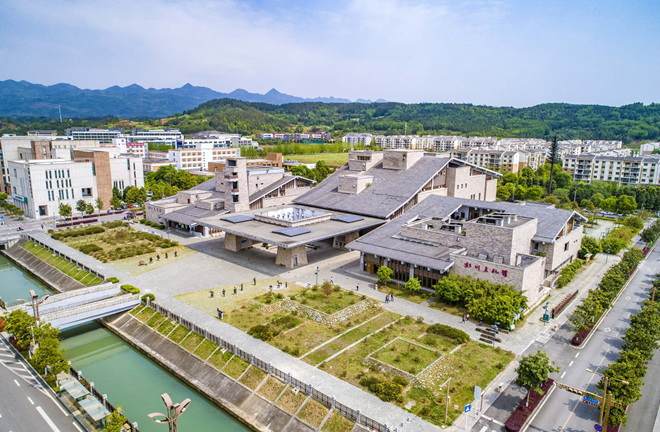Reflection on post-disaster reconstruction

An aerial view of the new location of Beichuan County. It is necessary to promote comprehensive planning to prepare for catastrophes, so that major projects can survive natural disasters.
The 2008 Wenchuan earthquake levelled Beichuan, the only Qiang Ethnic Minority Autonomous County in China, causing major economic loss. It was rebuilt in another location since the old county town became a ruin. Against this backdrop, a memorial park project was launched in the new county to commemorate the earthquake relief and post-disaster reconstruction. The Meditation Park is a masterpiece of connecting architecture with the environment. Its designer Zhou Kai doesn’t want to build the earthquake memorial architecture into a monument standing high into the sky. Instead, he hopes it could bring visitors some peace, allowing them to look back on the past and have a visceral conversation with the dead.
Memorial architecture aims to satisfy spiritual demands with no regard for material life. People may give thoughts, admire or worship in front of such buildings featuring distinctive characteristics, cultural connotations and extraordinary dimensions. Certain symbolic techniques can be adopted in the structures to reflect the memorial theme, which may frequently take creative forms and enable a consistency between ideas and arts. Clear themes are featured in memorial buildings, whether they are built to commemorate or praise something, to pay tribute or to record history. For example, the Flood Protection Monument in Wuhan, Hubei Province and the Flood Control Memorial Tower in Harbin, Heilongjiang Province both carry bright, vigorous and robust elements. Flood memorials for prayer should be silent and profound, where they can express sadness amid calmness.
Post-disaster reconstruction aims to rebuild a complete social structure in affected areas through a wide range of measures, so that fundamental social functions can be performed and necessary social order can be restored. Planning is the priority in this process. It is an inclusive task involving urban space development, land use, regional transportation as well as the protection of historical and cultural heritage, or even urban public facilities.
In fact, people across the world can enrich their understanding of disasters by participating in the planning of each reconstruction. The lessons from the 2008 Wenchuan earthquake have driven changes of people’s lives that the idea of integrated system as well as establishment of a smart and safe city are promoted. However, a considerable number of cities still have failed to emphasize safety issue and disaster reduction in the planning, with no substantial preparation for potential risks. They turn blind eyes to the law of nature and disguise disaster facts, as if nothing had happened, or nothing deserved awes. Forgetfulness of such kind is really disappointing.
Countermeasures to complicated urban catastrophes are necessary. Usually, the concept of disaster reduction stresses investigating general sources and stock of risks. The task focuses on curbing the increase of risks, so that the urban risk index of comprehensive disasters can remain under control through the safe operation of the city. Post-disaster reconstruction should avoid choosing a higher location for architecture. People in charge shouldn’t rush to a decision. Also, geological conditions of new locations shouldn’t be more vulnerable than the previous ones.
An inclusive capacity for disaster reduction should be developed. Kofi Annan, the former UN secretary, said prevention is not only more humane than post-disaster relief but also costs less. A heavy earthquake may or may not bring a tragedy depending on whether it occurs in a city capable of resisting it. The 6.9 magnitude earthquake that struck the Republic of Armenia of the Soviet Union in 1988 destroyed 80 percent of the buildings in Lenin Nampa and left 25,000 people dead. By contrast, only 63 people died from the 7.1 magnitude Loma Prieta earthquake in San Francisco one year later. This shows how crucial it is to improve planning of urban comprehensive prevention for major disasters.
China began research on seismic safety assessment and earthquake resistance in residential areas after the Tangshan and Wenchuan earthquakes. A series of laws and regulations have been launched as well. Regional natural disasters plus inappropriate human behaviors have undermined various construction projects ranging from Beijing-Tianjin-Hebei integration and large-scale city clusters to the “Belt and Road” initiative. Therefore, it is necessary to promote comprehensive planning to prepare for catastrophes at both national and international levels, so that major projects can survive natural disasters.
Education should focus on the dissemination of prevention measures. The UN International Strategy for Disaster Reduction advocates prevention as the primary task. Regulators at all levels should be prepared to deal with huge disasters by all means. Disaster culture and a sense of crisis are never absent from improving the ability to resist and reduce disaster. Disaster culture relates to not only theories but also experience drawn from the past, including knowledge of disaster prevention, judgement of disaster circumstances, physical and mental reactions to disasters as well as regulatory mechanism and legal system for disaster prevention.
The most valuable legacy of the 2008 Wenchuan earthquake is that our country has strengthened disaster-prevention education and construction at different social levels. But the efforts have not achieved the goals written in the Emergency Response Law of the People’s Republic of China, which calls for disaster reduction of all forms and by all means. Furthermore, there are only requirements on professional safety in the production field, far from promoting these issues to the entire social life.
(edited by MA YUHONG)
